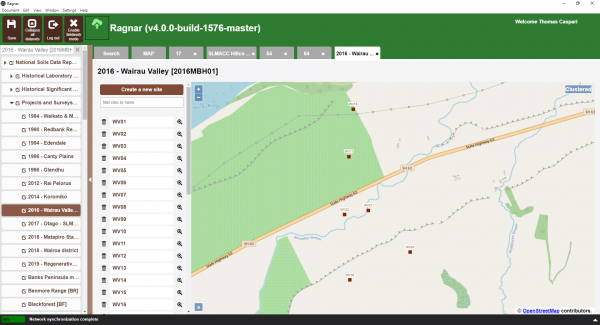National Soil Data Repository (NSDR)
A new development
An increasing realisation of the importance of soil to ensure productive food systems, improved rural livelihoods, and a sustainable healthy environment has seen a corresponding increase in the appreciation of the importance of soil data.
In June 2012 a review of the National Soils Database (NSD) identified a significant number of issues, and a plan of action was formulated to redevelop and improve the NSD to make it fit for purpose for today’s soil data needs.
Manaaki Whenua is now building a next generation, world-class soils observation data system.
Efforts have focused on two major areas:
- the design and implementation of a world class soils observation data system able to meet today’s needs for soil data, and
- a tool for capturing new and legacy soil data.
The goal of this next generation database is to be able to generate new soils information cost effectively from a diverse set of data sources. This will allow integration of a range of resources such as soil quality data, National Soils database data, and S-map observations.
Fully utilised, the NSDR will result in a more cohesive system for soil resource information accessed through a web portal and advanced web data services that conform to national data standards and international data sharing protocols.
Key characteristics
NSDR is a versatile soil observation database that now hosts the original National Soils Database (NSD). Whereas the original NSD was very specific in purpose – for storage and presentation of pedologic data sampled by horizon with a minimum suite of analytical results – the NSDR database has been specifically designed with the capability of housing a variety of soil datasets that differ in content, format, and utility, such as accommodating soils sampled by depth intervals or sites resampled over time.

Screenshot of the Data Entry Tool used by Manaaki Whenua – Landcare Research staff to facilitate data upload into the NSDR
An important requirement was a computer-based data entry tool to resolve the bottleneck of getting more data into the NSDR. This tool – ‘Ragnar’ – allows Manaaki Whenua staff to upload site and soil information directly into the NSDR database. Samples taken in the field can also be registered, and associated lab analysis results downloaded to Ragnar from the laboratory databases once they become available and linked to the related site data in the NSDR.
The new system also comes with a dedicated authorisation and identification tool, allowing secure access for customers to see their ‘own’ datasets.
The NSDR is designed and implemented so that each dataset can include full provenance information (such as detailed descriptions of the methods used to collect and analyse the data) while audit trails track changes to the data over time. Access to a dataset is managed ensuring that sensitive or confidential information can be securely stored and accessed. A key component of the NSDR is a registry of a full set of definitions for soil properties, their categorical value, related analysis methods, and units of measurement.
Database content
NSDR is a versatile soil observation database that now hosts:
- the original NSD
- the Overseas Database (mainly Pacific Islands)
- the national Soil Quality dataset ('500 soils')
- a set of 'legacy' datasets that had not been entered into NSD, and
- a growing number of soil datasets relating to recent and current projects.
The total number of soil sites covered across New Zealand and the Pacific currently stands at 18,000 sites (August 2019).
How to cite
If you need to cite the NSDR website or database in an article or report, please use the following citation:
Manaaki Whenua - Landcare Research 2020. National Soils Data Repository (NSDR). https://doi.org/10.26060/gcxk-e905